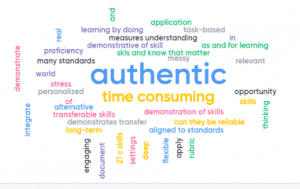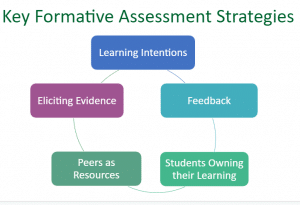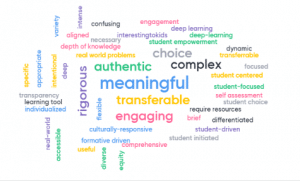Improving Student-Centered Assessment Systems With Formative and Summative Performance Assessments
CompetencyWorks Blog
In this second blog post of a four-part series, I dig deeper into the Vermont Agency of Education’s work to improve student-centered assessment systems by strengthening the use of performance assessments. Formative and summative performance assessments are essential for attaining equitable outcomes for all students and improving the effectiveness of educational systems.
One of the goals for the convenings we held on this topic is to work with educational leaders to refine tools and investigate resources they can use to improve local comprehensive assessment systems that support proficiency-based learning in their supervisory unions/districts.
Formative Assessment Probe: Performance Assessments
The convening described in this blog post started with this formative assessment probe: What words or phrases would you use to describe performance assessments? Mentimeter captured everyone’s ideas in a wordle and also provided background information to facilitators. The more times a word is entered, the larger it appears in the wordle. Below is the wordle that was generated in the beginning of the day. “Authentic” and “Time Consuming” are clearly attributes that were in the forefront of participants’ minds.

Current State of Assessment Systems: The Self-Reflection Tool
In order to dig a little deeper into the current state of assessment systems, particularly assessments for learning, we utilized a tool developed by the Assessment for Learning Project. This tool, the Request for Learning: Self Reflection Tool V2, provides an opportunity for educators to reflect and discuss their systems through the following lenses:
- Process: Assessment for learning is an integrated process;
- Priorities: Assessment for learning prioritizes feedback and reflection;
- Product: Assessment for learning produces bodies of evidence of learning; and
- Purpose: Assessment for learning enacts more equitable systems and learning environments.
Each “lens” of the Self-Reflection Tool is written as a continuum, such as in the image below.

Participants were asked to individually brainstorm all of the assessments within their systems on sticky notes, including one assessment on each note. Next, they each placed their assessments along one of the continua. This process provoked important discussions and questions. One educator commented how data from some of the assessments are not used and questioned the need for administering them. Two educators from the same school placed identical assessments at the opposite ends of a continuum. This discovery resulted in some laughter and then a discussion about the purpose of the assessment. Participants were also asked to look at the placements of their assessments and share thoughts regarding what an ideal continuum would look like.
This process was repeated for each of the four “lenses.” The hope is that leaders use this tool with educators to refine their assessment systems to reflect priority goals for teaching and learning, prevent the inclusion of duplicative assessments, and highlight assessments that generate data used to inform instruction.
Formative Assessment: Key Strategies
Next, we wanted to build a common understanding of formative assessment. Dylan Wiliam’s key formative assessment strategies were shared. Since Wiliam had previously worked with Vermont educators, some attendees were familiar with this work.

A modified jigsaw format was used with William’s Assessment: The Bridge Between Teaching and Learning document. During the first round, participants met with a peer and were responsible for communicating essential components of one strategy while learning about another one. Partners took notes about the new strategy and in the next round were expected to explain this strategy to someone else. The process was repeated numerous times. The purpose of this exercise was to develop common language related to formative assessment as well as to clarify our vision.
Educators often make the request: “Show me what it looks like.” We took advantage of a collaborative project, Models of Excellence, between EL Education and Harvard to do just that with formative assessment strategies. Participants watched the videos, Snakes Are Born This Way and Building Motivation and Skills through Whole-Class Research. Small groups then discussed the following questions:
- What key formative assessment strategies do you see the teacher using?
- What additional strategies might the teacher use?
These discussions helped everyone to deepen their understanding of formative assessment strategies by seeing what they actually might look like in a classroom. The videos also model the importance of actively engaging learners in formative performance assessments so that learning becomes visible. Additionally, these elementary videos were selected with the intent of showing what elementary students are capable of achieving. Just imagine what the possibilities are in middle and high school!
Essential Partners: Proficiency-Based Learning and Performance Assessment
In an effort to deepen participants’ knowledge of proficiency-based learning and connections to performance assessment, the Aurora Institute’s document, What Is Competency-Based Education? An Updated Definition, was explored. Participants were asked to read through the new definition of CBE/PBL and identify words or phrases they would like to see in bold. Empower, apply knowledge, differentiated support, timely feedback, learn actively, and rigorous were among the words/phrases selected. Within this definition, we noticed specific components with a direct link to performance assessments:
- Students are empowered daily to make important decisions about their learning experiences, how they will create and apply knowledge, and how they will demonstrate learning.
- Assessment is a meaningful, positive, and empowering learning experience for students that yields timely, relevant, and actionable evidence.
- Students receive timely, differentiated support based on their individual learning needs.
- Students progress based on evidence of mastery, not seat time.
Performance Assessments Defined
Now that we had spent much of the day clarifying the intent of assessments, discussing various types of formative performance assessments, and identifying connections between performance assessments and proficiency-based learning, we wanted the group to agree on a definition of performance assessments. Participants read and discussed related quotes. McTighe’s blog, What is a Performance Task?, as well as his An Intro to Performance Tasks: Guide to Engaging Students in Meaningful Learning, provided the group with a definition as well as descriptors of performance assessments. McTighe defines performance tasks [assessments] as any learning activity, investigation, or task that asks students to perform to demonstrate their knowledge, understanding, and proficiency level. Attributes of performance assessments include:
- Engage students in meaningful learning in authentic contexts;
- Can be student- or teacher-designed;
- Show genuine applications of knowledge;
- Yield a tangible product and/or performance that serve as evidence of learning; and
- Help integrate subject areas and 21st-century skills.
With agreement about the definition and attributes of performance assessments, participants were ready for the final activity of the day. It focused on refining the Quality Criteria for Performance Assessment template. This document is a synthesis of the work of others including SCALE and SCOPE. Since context matters, refinements and additions had previously been made to the original documents. Participants in the convening were asked to use the draft version of this document to review selected performance assessments and then identify strengths as well as suggestions for improvement. The feedback was used to improve and finalize the document.
Formative Assessment Probe Revisited: Performance Assessments
At the end of the day, we revisited our original question: What words or phrases would you use to describe performance assessments? I was glad to see that “time consuming,” although sometimes true about performance assessments, was no longer one of the most prominent words in the final wordle (shown below). Meaningful, authentic, transferable, engaging, complex, choice, and rigorous now stood out. Those are powerful descriptors and good reasons for including performance assessments within personalized and proficiency-based local comprehensive assessment systems.

Learn More
- Essential Components of Local Assessment Systems for Personalized, Proficiency-Based Learning
- Student-Designed Performance Assessments for Personalized Learning and Student Agency
- Supporting the Development of Student-Designed Performance Assessments
 Pat Fitzsimmons is Proficiency-Based Learning Team Leader at the Vermont Agency of Education. She collaborates with educators to implement proficiency-based learning and assessment systems that are student-centered. She has worked with various stakeholders to construct a Vermont Portrait of a Graduate and co-authored numerous documents related to proficiency-based learning. Before moving to state-level work, Pat was the Science Specialist for the Barre Supervisory Union in Vermont. She also fondly remembers her first fourteen years in public school as a kindergarten teacher. Pat was the first kindergarten teacher in Vermont to receive the Presidential Award for Excellence in Science Education.
Pat Fitzsimmons is Proficiency-Based Learning Team Leader at the Vermont Agency of Education. She collaborates with educators to implement proficiency-based learning and assessment systems that are student-centered. She has worked with various stakeholders to construct a Vermont Portrait of a Graduate and co-authored numerous documents related to proficiency-based learning. Before moving to state-level work, Pat was the Science Specialist for the Barre Supervisory Union in Vermont. She also fondly remembers her first fourteen years in public school as a kindergarten teacher. Pat was the first kindergarten teacher in Vermont to receive the Presidential Award for Excellence in Science Education.